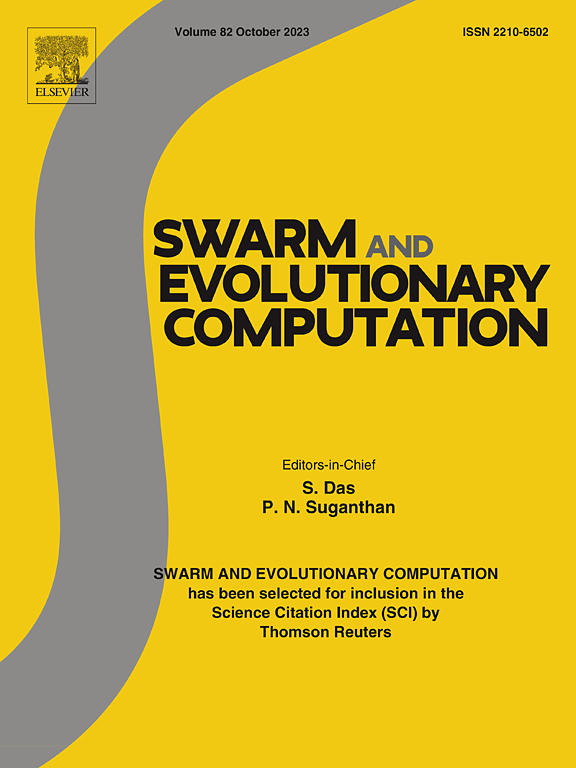Heterogeneous sensor integration through Co-Evolutionary Genetic Programming with Multiple Individual Representations
IF 8.5
1区 计算机科学
Q1 COMPUTER SCIENCE, ARTIFICIAL INTELLIGENCE
引用次数: 0
Abstract
Efficient integration of heterogeneous sensors is essential for optimizing complex sensor systems, however, variations in sensor types, data formats, and measurement units create significant challenges for seamless data integration and interoperability. Similarity Features (SFs) are commonly used to quantify relationships across diverse sensor data, yet no single SF is universally effective due to the inherent complexity of sensor data. Thus, combining multiple SFs is necessary for accurate integration. Although Genetic Programming (GP) offers a powerful solution for constructing SF combinations, it often encounters difficulties with the complex interactions in heterogeneous data, leading to local optima. To overcome these challenges, this paper introduces Co-Evolutionary Genetic Programming with Multiple Individual Representations (CEGP-MIR), which combines tree-based and linear GP representations to enhance the search and optimization process through dynamic population interaction. This approach includes a novel interaction mechanism for adaptive cooperation between representations and new crossover operators to prevent stagnation in local optima. Experiments use OAEI’s Benchmark, Conference datasets and ten real-world sensor datasets to test the performance of CEGP-MIR. Results demonstrate that the designed CEGP-MIR enhances sensor entity alignment and improves overall efficiency in heterogeneous sensor data integration.
基于多个体表示的协同进化遗传规划的异构传感器集成
异构传感器的有效集成对于优化复杂传感器系统至关重要,然而,传感器类型、数据格式和测量单元的变化为无缝数据集成和互操作性带来了重大挑战。相似特征(SF)通常用于量化不同传感器数据之间的关系,但由于传感器数据固有的复杂性,没有单一的SF是普遍有效的。因此,为了实现精确的积分,组合多个sf是必要的。尽管遗传规划(Genetic Programming, GP)为构造SF组合提供了一个强大的解决方案,但在异构数据中复杂的相互作用常常使其遇到困难,导致局部最优。为了克服这些挑战,本文引入了基于多个体表示的协同进化遗传规划(CEGP-MIR),该方法将基于树的遗传规划和线性GP表示相结合,通过动态种群交互来增强搜索和优化过程。该方法包括一种新的交互机制,用于表示之间的自适应合作和新的交叉算子,以防止在局部最优中停滞。实验使用OAEI的基准、会议数据集和十个实际传感器数据集来测试CEGP-MIR的性能。结果表明,设计的CEGP-MIR增强了传感器实体对齐,提高了异构传感器数据集成的整体效率。
本文章由计算机程序翻译,如有差异,请以英文原文为准。
求助全文
约1分钟内获得全文
求助全文
来源期刊

Swarm and Evolutionary Computation
COMPUTER SCIENCE, ARTIFICIAL INTELLIGENCEC-COMPUTER SCIENCE, THEORY & METHODS
CiteScore
16.00
自引率
12.00%
发文量
169
期刊介绍:
Swarm and Evolutionary Computation is a pioneering peer-reviewed journal focused on the latest research and advancements in nature-inspired intelligent computation using swarm and evolutionary algorithms. It covers theoretical, experimental, and practical aspects of these paradigms and their hybrids, promoting interdisciplinary research. The journal prioritizes the publication of high-quality, original articles that push the boundaries of evolutionary computation and swarm intelligence. Additionally, it welcomes survey papers on current topics and novel applications. Topics of interest include but are not limited to: Genetic Algorithms, and Genetic Programming, Evolution Strategies, and Evolutionary Programming, Differential Evolution, Artificial Immune Systems, Particle Swarms, Ant Colony, Bacterial Foraging, Artificial Bees, Fireflies Algorithm, Harmony Search, Artificial Life, Digital Organisms, Estimation of Distribution Algorithms, Stochastic Diffusion Search, Quantum Computing, Nano Computing, Membrane Computing, Human-centric Computing, Hybridization of Algorithms, Memetic Computing, Autonomic Computing, Self-organizing systems, Combinatorial, Discrete, Binary, Constrained, Multi-objective, Multi-modal, Dynamic, and Large-scale Optimization.
 求助内容:
求助内容: 应助结果提醒方式:
应助结果提醒方式:


